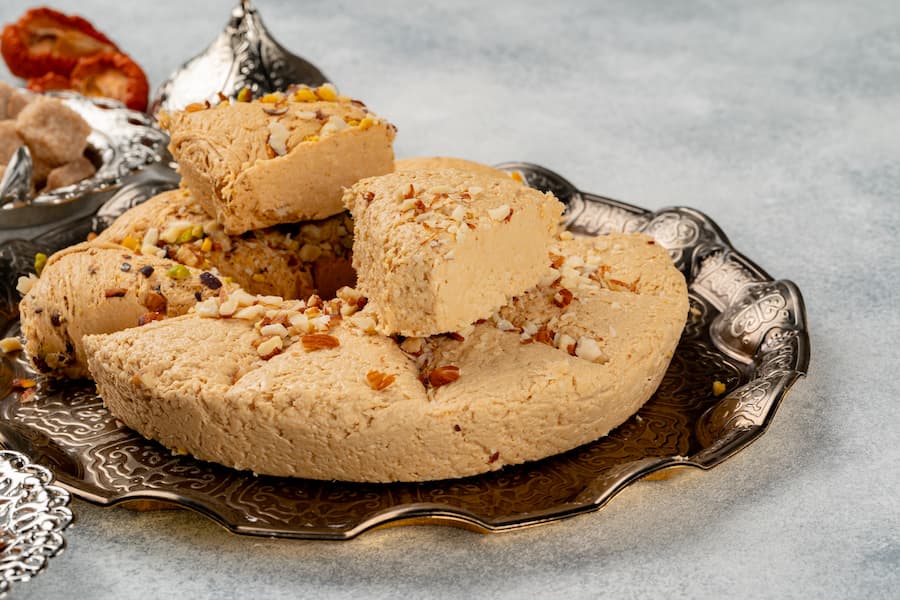What is halva? In fact, Halva, in different ways in many countries, although some dessert which is a particularly prevalent in Turkey and the Middle East. There are 3 most common types of halva: Flour halva, semolina halva and tahini halva. While flour halva and semolina halva are mostly made at home, tahini halva is bought ready-made from outside.

In addition to being delicious, halva is also a food that is very beneficial for your body. It is known to be healing for many diseases. If you consume it during the winter months, it acts as a great virus repellent for flu. If it is consumed in a balanced way, it also increases energy and body resistance.
It is important for school-age children or adults who have jobs that require physical strength during the day, in terms of energy. Due to the excess calcium in halva, bone resorption, etc. It is also good for ailments such as. Also; It has benefits such as reducing the risk of developing cancer, eliminating iron deficiency, protecting skin and hair health, providing the protein that our body needs, and positively affecting kidney health.
In addition to the many benefits of halva, it also has harmful sides for people with some diseases or people who consume excessive halva. People with diabetes should be careful while eating halva. If eaten too much, it can trigger the disease and cause health problems. Therefore, it should either be eaten under the control of an expert or not eaten in any way by not putting it at risk.
In addition, people who have trouble with protein consumption should be equally careful. While it provides a lot of benefits with the protein value in halva, it can be dangerous for people with diseases related to protein consumption. Although the consumption amount is not very important for young people and adults, especially elderly people should be careful when eating halva. In case of too much consumption, it can adversely affect health and cause diseases.
It is said in many places by experts that tahini halva is good for many diseases. Tahini is a very effective food for both your physical appearance and your illnesses. If you have a problem with hair loss or the texture of your skin, consuming tahini halva will be of great benefit to you. Tahini prevents hair loss, gives shine to the skin and revitalizes your skin.
Besides all these; It is good for vascular occlusion, especially in menopause period, it prevents bone resorption, eliminates accumulated toxins in the body, relieves migraine attacks, lowers high blood pressure, slows the progression of Alzheimer's disease and is good for eczema. As we can see from all these, tahini and tahini halva have great benefits on diseases.
The basic ingredients required to make flour halva are flour, sugar, oil and water. Semolina, oil, water, milk and sugar are required to make semolina halva. If you want to increase the aroma of the halva you make, it would be a good choice to use corn syrups in your recipes. Thus, you will soften the texture of the dish and increase its aroma. You can use molasses or honey instead of sugar in both recipes. The halva you make in this way will be healthier. In addition, you can make sugar-free halva without using sugar directly.
Since tahini halva is not made at home, there are many questions about how it is made. Thanks to the machines that have become more and more widespread in recent years, the preparation of tahini halva has become easier and faster. With the help of halva boiling, sugar boiling, halva kneading, halva weighing and halva cutting machines, the process of making tahini halva gradually began to be mechanized.
Tahini halva can be made ready-made both at home and with machines, but it is very difficult to cut properly after the tahini halva is made. Although it is not important to cut it properly if it is made for the family at home, it takes time to cut the tahini halva one by one manually, especially in the funeral or mass dinner parties or if it is produced ready-made in factories. In such cases, halva cutting machine is of great benefit. With the halva cutting machine, you can cut the tahini halva you have made from 200 gr to 2 kg in any portion size you want. Thus, you will reduce the physical work force to the maximum and avoid the situation of cutting one by one manually.